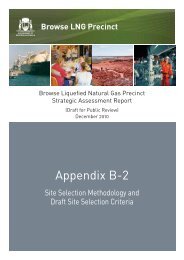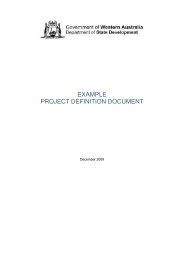Browse LNG Precinct - Public Information Booklet - Department of ...
Browse LNG Precinct - Public Information Booklet - Department of ...
Browse LNG Precinct - Public Information Booklet - Department of ...
You also want an ePaper? Increase the reach of your titles
YUMPU automatically turns print PDFs into web optimized ePapers that Google loves.
<strong>Public</strong> <strong>Information</strong> <strong>Booklet</strong><br />
The loading system for condensate is designed to minimise spills by having break away<br />
sections in the loading hose which are designed to shut in the condensate if there are<br />
problems with the hose.<br />
Although the possibility <strong>of</strong> spills is low, emergency spill response facilities will be provided<br />
by the <strong>Precinct</strong> proponents and an Oil Spill Contingency Plan will be in place to ensure<br />
that should an incident occur the spill will be managed so to minimise impacts to the<br />
environment.<br />
This initial oil spill response will be supported by a hierarchy <strong>of</strong> response systems and<br />
equipment. In particular the oil and gas industry jointly funds the Australian Marine Oil<br />
Spill Centre (AMOSC) which has a major stockpile <strong>of</strong> equipment based in Geelong<br />
(Victoria) and in Exmouth (WA). In addition there is the ability to access other spill<br />
response equipment in Singapore.<br />
This equipment is readily air transportable to provide a quick response time. Australiaís oil<br />
spill response is managed at the national level by the Australian Maritime Safety Authority<br />
under the National Plan to Combat Pollution <strong>of</strong> the Sea by Oil and other Noxious and<br />
Hazardous Substances (National Plan).<br />
Regular exercises will be undertaken by Woodside (and potentially other <strong>Precinct</strong><br />
proponents) to ensure emergency response equipment and processes are tested.<br />
Water Supply<br />
Question ñ What amount <strong>of</strong> water will be used and where is it coming from?<br />
The foundational development is anticipated to use in the order <strong>of</strong> 2-4 gigalitres annually<br />
<strong>of</strong> fresh water where a steam system is utilised as part <strong>of</strong> the selected <strong>LNG</strong> technology.<br />
This would equate to 8-16 gigalitres annually for the whole precinct if a similar <strong>LNG</strong><br />
technology was used by the other proponent/s.<br />
The freshwater is likely to come from either desalination <strong>of</strong> water from the Wallal aquifer<br />
or desalination <strong>of</strong> sea water. Desalination works by filtering sea water or brackish water<br />
(like that from the Wallal aquifer) through membranes to remove all small particles<br />
including salt. The resulting freshwater can be used for drinking, construction etc and the<br />
salty brine is discharged back into the sea.<br />
The Wallal aquifer is located approximately 200 metres (218 yards) below the ground and<br />
is slightly salty (around 2,500-3,500 parts per million salinity/salty water). This aquifer is<br />
separate to the shallower Broome aquifer that is suitable for general drinking without<br />
treatment.<br />
During construction it is possible that a temporary water supply will be required for<br />
construction prior to completion <strong>of</strong> the desalination system. It is likely that this will be<br />
from the Broome aquifer.<br />
In respect to the amount <strong>of</strong> ground water used, this will be in accordance with ground<br />
water licences and be subject to environmental impact assessment as part <strong>of</strong> the<br />
Strategic Assessment.<br />
5279225 75









